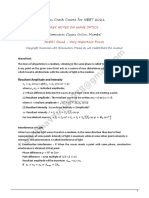Atomic Structure Key Notes PDF
Uploaded by
Jatin SinglaAtomic Structure Key Notes PDF
Uploaded by
Jatin SinglaBIOMENTORS CHEMISTRY CRASH COURSE FOR NEET 2019
KEY NOTES on ATOMIC STRUCTURE
Chemistry by Dr Sanjay Singh
1. According to John Dalton matter is made up of extremely tiny indivisible particles, called atom which
participates in chemical reactions. Atoms can neither be created nor be destroyed.
2. ELECTRON: -
• Electron was discovered by J.J. Thomson and is negatively charged particle.
• Electron is a component particle of cathode rays.
• Cathode rays were discovered by William Crooke's & J.J. Thomson
3. Properties of Cathode rays
• Cathode rays consist of negatively charged particles known as electron.
• Cathode rays can cause fluorescence.
• Cathode rays heat the object on which they fall due to transfer of kinetic energy to the object.
• When cathode rays fall on metals such as Cu , X - rays are produced.
• Cathode rays possess ionizing power i.e., they ionize the gas through which they pass.
4. PROTON
• Proton was discovered by Goldstein and is positively charged particle.
• It is a component particle of anode rays.
5. PROPERTIES OF ANODE RAYS
• Anode rays may get deflected by external magnetic field.
• Anode rays also affect the photographic plate.
• The e/m ratio of these rays is smaller than that of electrons.
• Unlike cathode rays, their e/m value is dependent upon the nature of the gas taken in the
tube. It is maximum when gas present in the tube is hydrogen.
• These rays produce flashes of light on ZnS screen.
COMPARISON OF MASS, CHARGE AND SPECIFIC CHARGE OF ELECTRON, PROTON AND NEUTRON
Name of constant Unit Electron(e–) Proton(p+) Neutron(n)
Amu 0.000546 1.00728 1.00899
Mass (m) Kg 9.109 × 10–31 1.673 × 10–27 1.675 × 10–27
Relative 1/1837 1 1
Coulomb (C) – 1.602 × 10–19 +1.602 × 10–19 Zero
Charge(e) Esu – 4.8 × 10–10 +4.8 × 10–10 Zero
Relative –1 +1 Zero
Specific charge (e/m) C/g 1.76 × 108 9.58 × 104 Zero
Density Gram / cc 2 . 17 ´ 10 -17 1 . 114 ´ 10 14 1 . 5 ´ 10 -14
6. The atomic mass unit (amu) is 1/12 of the mass of an individual atom of 6 C 12 , i.e. 1 .660 ´ 10 -27 kg
7. Neutron was discovered by James Chadwick according to the following nuclear reaction,
4 Be 9 + 2 He 4 ® 6 C 12 + o n1
8. Neutron is an unstable particle. It decays as follows,
0n
1
0n ¾¾® 1 H 1 + -1 e
0
+ 0
neutron Proton electon antinutrin o
Different types of atomic species
Atomic Similarities Differences Examples
species
Isotopes (i) Atomic No. (Z) (i) Mass No. (A) (i) 11 H , 12 H , 13 H
(ii) No. of protons (ii) No. of neutrons (ii) 16 17 18
8 O, 8 O, 8 O
(iii) No. of electrons (iii) Physical properties (iii) 35
17
37
Cl , 17 Cl
(iv) Electronic configuration
(v) Chemical properties
(vi) Position in the periodic
table
Isobars (i) Mass No. (A) (i) Atomic No. (Z) (i) 40
18
40
Ar , 19 K , 40
20 Ca
(ii) No. of nucleons (ii) No. of protons, electrons (ii) 130
52 Te , 130 130
54 Xe , 56 Ba
and neutrons
(iii)Electronic configuration
(iv) Chemical properties
(v) Position in the perodic
table.
Isotones No. of neutrons (i) Atomic No. (i) 30
14
31
Si , 15 32
P , 16 S
(ii) Mass No., protons and (ii) 39
19 K , 40
20 Ca
electrons.
(iii) 13 H , 42 He
(iii) Electronic configuration
(iv) 13 14
6 C, 7 N
(iv) Physical and chemical
properties
(v) Position in the periodic
table.
Isoelectroni (i) No. of electrons At. No., mass No. (i) N 2 O , CO 2 , CNO - (22 e - )
c species (ii) Electronic configuration (ii) CO , CN - , N 2 (14 e - )
(iii) H - , He , Li + , Be 2 + (2e - )
9. HYDROGEN SPECTRUM : Hydrogen spectrum is an example of line emission spectrum or atomic
emission spectrum. When an electric discharge is passed through hydrogen gas at low pressure, a
bluish light is emitted. This light shows discontinuous line spectrum of several isolated sharp lines
through prism. All these lines of H-spectrum have Lyman, Balmer, Paschen, Brackett, Pfund series.
Wavelength of various H-lines spectrum can be given by following expression,
1 n é1 1 ù
n = = = Rê 2 - 2 ú
l c êë n1 n 2 úû
Where R is universal constant known as Rydberg’s constant.
10. PLUM PUDDING MODEL OF THOMSON: He suggested that atom is a positively charged sphere
having electrons embedded uniformly giving an overall picture of plum pudding.
Positively charged sphere
–
+ +
– –
+ +
–
Electron unifromly
+
– embedded
+
– +
Positive charge spreaded throughout sphere
11. RUTHERFORD'S NUCLEAR MODEL
Rutherford carried out experiment on the bombardment of thin (10–4 mm) Au foil with high speed
positively charged a - particles emitted from Ra and gave the following observations based on this
experiment, Most of the a - particles passed without any deflection. Some of them were deflected
away from their path. only a few (one in about 10,000) were returned back to their original direction of
propagation.
From the experimental observations he concluded that, an atom consists of
(i) Nucleus which is small in size but carries the entire mass i.e. contains all the neutrons and protons.
(ii) Extra nuclear part which contains electrons. It is called as planetary model.
12. PROPERTIES OF THE NUCLEUS
(i) Nucleus is a small, heavy, positively charged portion of the atom & located at the centre of the atom.
(ii) All the positive charge of atom (i.e. protons) are present in nucleus.
(iii) Nucleus contains neutrons and protons, à collectively are also referred to as nucleons.
(iv) The size of nucleus is measured in Fermi (1 Fermi = 10–13 cm).
(v) The radius of nucleus is of the order of 1 .5 ´ 10 -13 cm. to 6 .5 ´ 10 -13 cm. i.e. 1 .5 to 6 .5 Fermi.
Generally the radius of the nucleus ( rn ) is given by the following relation,
rn = ro (= 1 . 4 ´ 10 -13 cm) ´ A 1 / 3
This exhibited that nucleus is 10 -5 times small in size as compared to the total size of atom.
13. PLANCK'S QUANTUM THEORY
(i) The radiant energy which is emitted or absorbed by body is the form of small discrete packets of
energy, each such packet of energy is called as 'quanta’ or ‘photon’.
(ii) The energy of each quantum is directly proportional to the frequency ( n ) of the radiation, i.e.
hc
E µn or
E = hv =
l
Where, h = Planck's constant = 6.62×10–27 erg. sec. or 6 .62 ´ 10 -34 Joules sec .
14. PHOTOELECTRIC EFFECT
(1) When radiations with certain minimum frequency (n 0 ) strike the surface of a metal, the electrons are
ejected from the surface of the metal. This phenomenon is called photoelectric effect and the electrons
emitted are called photo-electrons. The current constituted by photoelectrons is known as
photoelectric current.
(2) The electrons are ejected only if the radiation striking the surface of the metal has at least a
minimum frequency (n 0 ) called Threshold frequency. The minimum potential at which the plate
photoelectric current becomes zero is called stopping potential.
(3) The velocity of the electron ejected depend upon the frequency of the incident radiation and is
independent of its intensity.
(4) The number of photoelectrons ejected is proportional to the intensity of incident radiation.
(5) Einstein’s photoelectric effect equation
According to Einstein,
Maximum kinetic energy of the ejected electron = absorbed energy – threshold energy
1 é1 1 ù
2
mv max = hn - hn 0 = hc ê - ú
2 ë l l 0 û
Where, n 0 and l0 are threshold frequency and threshold wavelength.
15. BOHR’S ATOMIC MODEL
Bohr gave the idea of atom in the form of his postulates.
The electrons revolve around the nucleus in certain permitted circular orbits of definite radii.
The permitted orbits are those for which the angular momentum of an electron is an integral multiple
of h / 2p where h is the Planck’s constant.
If m is the mass and v is the velocity of the electron in a permitted orbit of radius r, then
nh
L = mvr = ; n = 1 , 2, 3, …… ¥
2P
Where L is the orbital angular momentum and n is the number of orbit.
The integer n is called the principal quantum number.
This equation is known as the Bohr quantization postulate.
When electrons move in permitted discrete orbits they do not radiate or lose energy. Such orbits are
called stationary or non-radiating orbits called as K , L, M , N , …. etc.
Ordinarily an electron continues to move in a particular stationary state or orbit.
Such a state of atom is called ground state.
When energy is given to the electron it jumps to any higher energy level and is said to be in the
excited state. When the electron jumps from higher to lower energy state, the energy is radiated.
16. CALCULATION OF RADIUS OF BOHR’S ORBIT :
According to Bohr, radius of nth orbit in which electron moves is
é h2 ù n2
rn = ê 2 2 ú.
êë 4 p me k úû Z
n2
rn = ´ 0 . 529 Å
Z
Calculation of velocity of electron
1/2
2pe 2 ZK é Ze 2 ù 2 . 188 ´ 10 8 Z -1
Vn = , Vn = ê ú ;
Vn = cm. sec
nh êë mr úû n
Calculation of energy of electron in Bohr’s orbit
kZe 2 kZe 2 kZe 2
Total energy of electron = K.E. + P.E. of electron = - =-
2r r 2r
- 2p 2 mZ 2 e 4 k 2
E=
n 2 h2 Where, n=1, 2, 3………. ¥
-1312 2 -1
E=
Z kJmol
n2
When an electron jumps from an outer orbit (higher energy) n2 to an inner orbit (lower energy) n1 , then the
energy emitted in form of radiation is given by
2p 2 k 2 me 4 Z 2 æ 1 1 ö
DE = E n2 - E n1 = ç ÷
h2 ç n2 - n2 ÷
è 1 2 ø
æ 1 1 ö÷ 2ç
Þ DE = 13 . 6 Z ç 2 - 2 ÷eV / atom
è n1 n2 ø
17. HYDROGEN SPECTRUM
The light absorbed or emitted as a result of an electron changing orbits produces characteristic
absorption or emission spectra which can be recorded on the photographic plates as a series of lines,
the optical spectrum of hydrogen consists of several series of lines called Lyman, Balmar, Paschen,
Brackett, Pfund and Humphrey. These spectral series were named by the name of scientist who
discovered them.
To evaluate wavelength of various H-lines Ritz introduced the following expression,
1 n é1 1 ù
n = = = Rê 2 - 2 ú
l c êë n1 n2 úû
2p 2 me 4
=
Where, R is = ch3 Rydberg's constant
If an electron from nth excited state comes to various energy states, the maximum spectral lines
n(n - 1)
obtained will be =
. n= principal quantum number.
2
4(4 - 1) 12
As n=4 than total number of spectral lines =
= = 6.
2 2
S.No Spectral Transitio lmax =
n12n22 n12 l max n2 Lies in the
l min = = 2 2 2
(n22- n12 )R R l min n 2 - n1
. series n region
n2 > n1
(1) Lymen n1 = 1 n1 = 1 and n 2 = 2 n1 = 1 and n 2 = ¥ 4 Ultraviolet
3
series n 2 = 2,3,4 .... ¥ 4 1 region
l max = l min =
3R R
(2) Balmer n1 = 2 n1 = 2 and n 2 = 3 n1 = 2 and n2 = ¥ Visible region
series n 2 = 3,4 ,5 .... ¥ 36 4 9
l max = l min =
5R R 5
(3) Paschen n1 = 3 n1 = 3 and n 2 = 4 n1 = 3 and n 2 = ¥ 16 Infra red region
7
series n 2 = 4 ,5,6 .... ¥ 144 9
l max = l min =
7R R
(4) Brackett n1 = 4 n1 = 4 and n2 = 5 n1 = 4 and n 2 = ¥ 25 Infra red region
9
series n 2 = 5,6,7 .... ¥ 16 ´ 25 16
lmax = l min =
9R R
(5) Pfund n1 = 5 n1 = 5 and n 2 = 6 n1 = 5 and n 2 = ¥ 36 Infra red region
11
series n 2 = 6,7,8 .... ¥ l max =
25 ´ 36
l min =
25
11 R R
(6) Humphrey n1 = 6 n1 = 6 and n 2 = 7 n1 = 6 and n 2 = ¥ 49 Far infrared
13
series n 2 = 7,8 .... ¥
l max =
36 ´ 49
l min =
36 region
13 R R
DUAL NATURE OF ELECTRON
Small particles like electrons when in motion possess wave properties.
According to de-broglie, the wavelength associated with a particle of mass m, moving with velocity v is given
by the relation
h
l= , where h = Planck’s constant.
mv
The de-Broglie equation is applicable to all material objects but it has significance only in case of
microscopic particles. Since, we come across macroscopic objects in our everyday life, de-broglie
relationship has no significance in everyday life.
HEISENBERG’S UNCERTAINTY PRINCIPLE
This principle states “It is impossible to specify at any given moment both the position and momentum
(velocity) of an electron”.
h
Mathematically it is represented as , Dx . Dp ³
4p
Where Dx = uncertainty is position of the particle, Dp = uncertainty in the momentum of the particle
Now since Dp = m Dv
h h
So equation becomes, Dx . m Dv ³ 4p or Dx ´ Dv ³
4 pm
QUANTUM NUMBERS
Each orbital in an atom is specified by a set of three quantum numbers (n, l, m) and each electron is
designated by a set of four quantum numbers (n, l, m and s).
(1) Principle quantum number (n)
It determines the average distance between electron and nucleus, means it denotes the size of atom.
It determines the energy of the electron in an orbit where electron is present.
The maximum number of an electron in an orbit represented by this quantum number as 2n 2 .
(2) Azimuthal quantum number (l)
Azimuthal quantum number is also known as angular quantum number. Proposed by
Sommerfield and denoted by ‘l’.
It tells about the shape of subshells.
It also expresses the energies of subshells s < p < d < f (increasing energy).
The value of l = (n - 1) always. Where ‘n’ is the number of principle shell.
Value of l = 0 1 2 3
Name of = S P d f
subshell
Shape of = Spherical Dumbbel Double Complex
subshell l dumbbell
h
It represent the orbital angular momentum. Which is equal to l(l + 1)
2p
The maximum number of electrons in subshell = 2(2l + 1)
(3) MAGNETIC QUANTUM NUMBER (M)
It gives the number of permitted orientation of subshells.
The value of m varies from –l to +l through zero.
For a given value of ‘n’ the total value of ’m’ is equal to n 2 .
For a given value of ‘l’ the total value of ‘m’ is equal to (2l + 1).
(4) SPIN QUANTUM NUMBERS (S)
The value of ' s' is + 1/2 and - 1/2, which signifies the spin or rotation or direction of electron on it’s axis
h
during movement. It represents the value of spin angular momentum is equal to s(s + 1).
2p
DISTRIBUTION OF ELECTRONS AMONG THE QUANTUM LEVELS
N l M Designation of Number of Orbitals in the
orbitals subshell
1 0 0 1s 1
2 0 0 2s 1
2 1 –1, 0, +1 2p 3
3 0 0 3s 1
3 1 –1, 0, +1 3p 3
3 2 –2, –1, 0, +1, +2 3d 5
4 0 0 4s 1
4 1 –1, 0, +1 4p 3
4 2 –2, –1, 0, +1, +2 4d 5
4 3 –3, –2, –1, 0, +1, +2, +3 4f 7
RULES FOR FILLING OF ELECTRONS IN VARIOUS ORBITALS
The atom is built up by filling electrons in various orbitals according to the following rules,
(1) Aufbau’s principle
This principle states that the electrons are added one by one to the various orbitals in order of their
increasing energy starting with the orbital of lowest energy. The increasing order of energy of various
orbitals is
1s < 2 s < 2 p < 3 s < 3 p < 4 s < 3 d < 4 p < 5 s < 4 d < 5 p < 6 s < 4 f < 5 d < 6 p < 7 s < 5 f < 6 d < 7 p.........
(2) (n+l) Rule
In neutral isolated atom, the lower the value of (n + l) for an orbital, lower is its energy. However, if the
two different types of orbitals have the same value of (n + l), the orbitals with lower value of n has lower
energy.
(3) Pauli’s exclusion principle
According to this principle “no two electrons in an atom will have same value of all the four quantum
numbers”. In other words an orbital can hold not more than two electrons.
(4) Hund’s Rule of maximum multiplicity
“Electron pairing in p, d and f orbitals cannot occur until each orbitals of a given subshell contains
one electron each or is singly occupied”.
10
You might also like
- Conversion To Christianity Among The Nagas100% (4)Conversion To Christianity Among The Nagas44 pages
- Class 11 Biology Topic Wise Line by Line Chapter 4 Chemical Bonding and Molecular StructureNo ratings yetClass 11 Biology Topic Wise Line by Line Chapter 4 Chemical Bonding and Molecular Structure39 pages
- Performance Enhancement Biology Basics Part 150% (2)Performance Enhancement Biology Basics Part 16 pages
- M-Caps-02: Chemistry: NEET - XI StudyingNo ratings yetM-Caps-02: Chemistry: NEET - XI Studying3 pages
- Xii-Neet Final Question Paper - 10.10.2021No ratings yetXii-Neet Final Question Paper - 10.10.202119 pages
- 750- Blockbuster Problems in Biology for NEET_nodrmNo ratings yet750- Blockbuster Problems in Biology for NEET_nodrm201 pages
- NCERT 12th Physics Chapterwise Exempler Solution Important For Neet Aipmt IIT JEE Main and Advanced 12th Boards Exams Book Bank Publication PDF100% (2)NCERT 12th Physics Chapterwise Exempler Solution Important For Neet Aipmt IIT JEE Main and Advanced 12th Boards Exams Book Bank Publication PDF266 pages
- 01-12-210 Question AllenTestPaper - UnlockedNo ratings yet01-12-210 Question AllenTestPaper - Unlocked20 pages
- Medical VMC Medical Revision Test-03 (VRTS-03) 10PMT20 & 11PMT20No ratings yetMedical VMC Medical Revision Test-03 (VRTS-03) 10PMT20 & 11PMT2022 pages
- 25 - Ray Optics and Optical Instruments - KeynotesNo ratings yet25 - Ray Optics and Optical Instruments - Keynotes28 pages
- Xii Pass Neet CPT 21 QP Ex DT 04-04-2022No ratings yetXii Pass Neet CPT 21 QP Ex DT 04-04-202224 pages
- MOLECULAR BASIS OF INHERITANCE With Answers Final 5 SepNo ratings yetMOLECULAR BASIS OF INHERITANCE With Answers Final 5 Sep13 pages
- (TS) Incoming SR Elite & Aiims s60 Neet Weekend Test - 8 Paper (05!10!2021)No ratings yet(TS) Incoming SR Elite & Aiims s60 Neet Weekend Test - 8 Paper (05!10!2021)22 pages
- LT - & Xii - Neet - GT - 9 (Set - 1) QP - 29.04.2024No ratings yetLT - & Xii - Neet - GT - 9 (Set - 1) QP - 29.04.202421 pages
- SR Elite, SR Aiims s60 & SR Neet MPL Neet Part Test - 4 Paper - 22!01!19No ratings yetSR Elite, SR Aiims s60 & SR Neet MPL Neet Part Test - 4 Paper - 22!01!1920 pages
- LT - & Xii - Neet - GT - 5 (Set - 1) QP - 24.04.2024No ratings yetLT - & Xii - Neet - GT - 5 (Set - 1) QP - 24.04.202421 pages
- 2013 Karnataka NEET 2013 Question Exam Paper - KarnatakaNo ratings yet2013 Karnataka NEET 2013 Question Exam Paper - Karnataka22 pages
- Unit-X Chapter-13. Organism and Population: Important PointsNo ratings yetUnit-X Chapter-13. Organism and Population: Important Points15 pages
- Motion in A Plane NCERT LINE BY LINE MCQNo ratings yetMotion in A Plane NCERT LINE BY LINE MCQ29 pages
- Prince Singh: Physical & Inorganic ChemistryNo ratings yetPrince Singh: Physical & Inorganic Chemistry5 pages
- Prince Singh: Physical & Inorganic Chemistry100% (1)Prince Singh: Physical & Inorganic Chemistry5 pages
- Prince Singh: Physical & Inorganic ChemistryNo ratings yetPrince Singh: Physical & Inorganic Chemistry5 pages
- DAILY PRACTICE SHEET - 195 - t8AXXWL PDFNo ratings yetDAILY PRACTICE SHEET - 195 - t8AXXWL PDF4 pages
- Prince Singh Atomic Structure Chemical Kinetics: Physical & Inorganic ChemistryNo ratings yetPrince Singh Atomic Structure Chemical Kinetics: Physical & Inorganic Chemistry6 pages
- Health6 - Q4 - ImportanceOfConsumerHealthNo ratings yetHealth6 - Q4 - ImportanceOfConsumerHealth22 pages
- Western Civilization 9th Edition Jackson J. Spielvogel - Read the ebook online or download it as you prefer100% (1)Western Civilization 9th Edition Jackson J. Spielvogel - Read the ebook online or download it as you prefer52 pages
- Relationship Between Cognitive Dissonance and Achievement in Mathematics Among Higher Secondary School StudentsNo ratings yetRelationship Between Cognitive Dissonance and Achievement in Mathematics Among Higher Secondary School Students5 pages
- AC500 High Availability Library For CM574-RSNo ratings yetAC500 High Availability Library For CM574-RS2 pages
- Express Limited Warranty: FORM 6315 First EditionNo ratings yetExpress Limited Warranty: FORM 6315 First Edition2 pages
- Joining The Ties of Kinship - Islamic NetworkNo ratings yetJoining The Ties of Kinship - Islamic Network4 pages
- Williams, Kenneth R. - The Natural Calculator (1991)100% (2)Williams, Kenneth R. - The Natural Calculator (1991)111 pages
- Stakeholder Analysis Matrix (3.3.2) (10.1)No ratings yetStakeholder Analysis Matrix (3.3.2) (10.1)1 page
- Class 11 Biology Topic Wise Line by Line Chapter 4 Chemical Bonding and Molecular StructureClass 11 Biology Topic Wise Line by Line Chapter 4 Chemical Bonding and Molecular Structure
- 750- Blockbuster Problems in Biology for NEET_nodrm750- Blockbuster Problems in Biology for NEET_nodrm
- NCERT 12th Physics Chapterwise Exempler Solution Important For Neet Aipmt IIT JEE Main and Advanced 12th Boards Exams Book Bank Publication PDFNCERT 12th Physics Chapterwise Exempler Solution Important For Neet Aipmt IIT JEE Main and Advanced 12th Boards Exams Book Bank Publication PDF
- Medical VMC Medical Revision Test-03 (VRTS-03) 10PMT20 & 11PMT20Medical VMC Medical Revision Test-03 (VRTS-03) 10PMT20 & 11PMT20
- 25 - Ray Optics and Optical Instruments - Keynotes25 - Ray Optics and Optical Instruments - Keynotes
- MOLECULAR BASIS OF INHERITANCE With Answers Final 5 SepMOLECULAR BASIS OF INHERITANCE With Answers Final 5 Sep
- (TS) Incoming SR Elite & Aiims s60 Neet Weekend Test - 8 Paper (05!10!2021)(TS) Incoming SR Elite & Aiims s60 Neet Weekend Test - 8 Paper (05!10!2021)
- LT - & Xii - Neet - GT - 9 (Set - 1) QP - 29.04.2024LT - & Xii - Neet - GT - 9 (Set - 1) QP - 29.04.2024
- SR Elite, SR Aiims s60 & SR Neet MPL Neet Part Test - 4 Paper - 22!01!19SR Elite, SR Aiims s60 & SR Neet MPL Neet Part Test - 4 Paper - 22!01!19
- LT - & Xii - Neet - GT - 5 (Set - 1) QP - 24.04.2024LT - & Xii - Neet - GT - 5 (Set - 1) QP - 24.04.2024
- 2013 Karnataka NEET 2013 Question Exam Paper - Karnataka2013 Karnataka NEET 2013 Question Exam Paper - Karnataka
- Unit-X Chapter-13. Organism and Population: Important PointsUnit-X Chapter-13. Organism and Population: Important Points
- Prince Singh Atomic Structure Chemical Kinetics: Physical & Inorganic ChemistryPrince Singh Atomic Structure Chemical Kinetics: Physical & Inorganic Chemistry
- Western Civilization 9th Edition Jackson J. Spielvogel - Read the ebook online or download it as you preferWestern Civilization 9th Edition Jackson J. Spielvogel - Read the ebook online or download it as you prefer
- Relationship Between Cognitive Dissonance and Achievement in Mathematics Among Higher Secondary School StudentsRelationship Between Cognitive Dissonance and Achievement in Mathematics Among Higher Secondary School Students
- Williams, Kenneth R. - The Natural Calculator (1991)Williams, Kenneth R. - The Natural Calculator (1991)














































































































